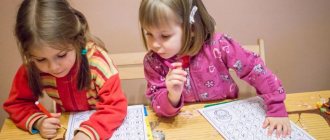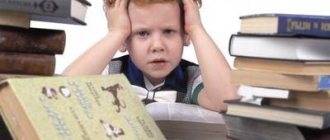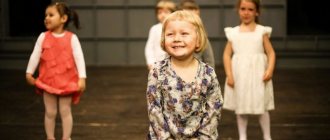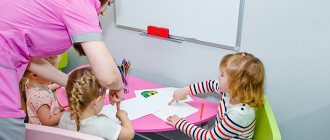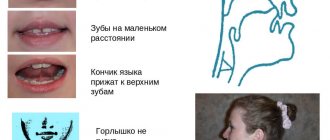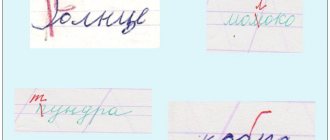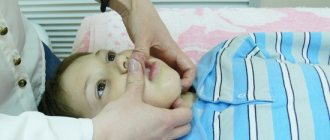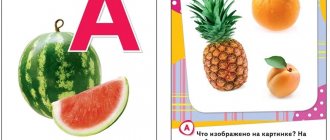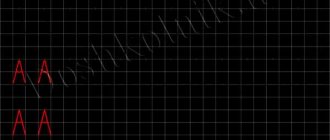The methodological development “Correction of optical dysgraphia using the example of differentiating the letters b-d using the technique of sculpting letters from plasticine based on game methods” highlights the relevance of the problem of correcting writing disorders in primary schoolchildren within the framework of the vision of the writing process as a complex form of speech activity, considers scientific, methodological and methodological grounds and relevance of the author's development.
This methodological development reveals the stages, methods of work, correctional and developmental exercises for optical dysgraphia using the example of mixing the writing of the letters “b d” using the technique of sculpting letters from plasticine and elements of the game.
In conclusion, resources, timing and expected results of the effective implementation of methodological development, criteria for assessing the achievement of planned results are presented.
The problem of studying and correcting dysgraphia in children is currently one of the important tasks of speech therapy. This is due to the insufficient effectiveness of traditional methods for correcting dysgraphia, with an increase in the number of students with writing disorders, as well as with the complication of the symptoms and mechanisms of this disorder. Specific writing disorders entail impairments in mastering spelling and are often the cause of persistent academic failure and deviations in the formation of a child’s personality.
In this regard, one of the urgent tasks of speech therapy remains the search for optimal ways to correct dysgraphia. This determined the theme of the methodological development: “Correction of optical dysgraphia using the technique of sculpting letters from plasticine using the example of differentiating the letters b-d.”
Writing as a complex form of speech activity
Writing is a complex, systemic, voluntary mental activity, which is ensured by the participation of various structural and functional components. Writing is closely related to oral speech and is carried out only on the basis of a sufficiently high level of its development. However, the development of oral speech is only one of the prerequisites for successful mastery of writing.
Writing is ensured by the coordinated activity of the occipital, parietal regions of the cortex, the temporal region of the left hemisphere of the brain, which are the cortical sections of the analytical systems, as well as the anterior sections of the cerebral cortex, associated with the organization of the flow of movements in time, with the development and preservation of motor skills and with the organization of complex purposeful actions .
For the timely and complete development of writing in children, a number of prerequisites are necessary - the formation (preservation) of oral speech, visual and visual-spatial perception, the motor sphere - subtle movements of the fingers and hands, self-regulation and control of one’s own activities.
Both oral and written forms of speech represent a type of temporary connections of the second signaling system. Unlike oral speech, written speech is formed only under conditions of targeted learning, i.e. its mechanisms develop during the period of learning to read and write and are improved during all further training. At the initial stage of mastering the skill of writing, the role of pronunciation is very important. Pronunciation helps clarify the nature of a sound, distinguish it from similar sounds, and determine the sequence of sounds in a word.
The problem of schoolchildren mastering the skill of writing is one of the most pressing, since writing and reading from the purpose of primary education are turning into a means of further acquisition of knowledge by students.
Scientific, methodological and methodological basis of the author's development
Dysgraphia is defined as a partial specific impairment of writing, caused by the immaturity (impairment) of higher mental functions and manifested in repeated errors of a persistent nature.
With optical dysgraphia, distorted reproduction of letters in writing is observed (incorrect spatial relationship of letter elements, mirror writing of letters, underwriting of elements or building up of elements, replacement and mixing of graphically similar letters). In this regard, in the process of speech therapy work, the development of visual-spatial functions is carried out, which makes it possible in the future to form clear visual images of letters and the skill of quickly distinguishing graphically similar letters.
The sensorimotor basis of a child’s mental development is the coordination that occurs between the eye and hand, between hearing and voice. The main means of cognition of spatial features and relationships between objects of the external world becomes active touch with the hands together with vision, which can be sufficiently worked out using the technique of modeling from plasticine.
The process of developing a certain mental function during the correction of optical dysgraphia, according to the principle of taking into account the “zone of proximal development” according to L. S. Vygotsky, should be carried out taking into account the level at which task completion is possible with little help from the teacher - speech therapist. Using the technique of sculpting letters from plasticine gives the child the opportunity to design independently.
To increase the effectiveness of corrective action, especially in the initial stages of work, it is advisable to adhere to the principle of maximum reliance on various analyzers: visual, auditory, tactile, as well as inter-analyzer interaction. Using the technique of modeling from plasticine allows you to create a vivid image of a letter and stimulate the work of the visual analyzer. By running the fingers of the dominant hand over the sculpted letter, we develop tactile sensations and fine motor skills of the hands. Simultaneously speaking aloud and tracing the contour of a plasticine letter strengthens the connections between phoneme - articulome - grapheme - kineme.
Movement of a hand with a sculpted letter from left to right and from top to bottom with visual control turned on forms visual-spatial coordination. The joint and alternate work of hands tracing the contour of a sculpted letter promotes the development of interhemispheric connections. The soft structure of plasticine has a relaxing effect, which creates a positive background for corrective work.
The ability to construct and reconstruct a letter from plasticine, to determine the similarities and differences between graphically similar letters develops children's thinking processes, attention and spatial concepts. In the process of speech therapy sessions, it is important not only to form a mental action, but also to bring it to automatism.
Repeated sculpting of the letter from plasticine helps us consolidate the image of the letter.
In the process of correction of optical dysgraphia, it is necessary to observe the principle of gradual (“step-by-step”) formation of mental functions. In this regard, at each speech therapy lesson it is necessary to complicate the speech material, using a sound, syllable, word, phrase, sentence and text with a given letter.
Performance control and feedback (afferentation) occurs through kinesthesia. When children sculpt from plasticine, they rely on the “memory of the hand.” Visual control of movement is almost absent. Gradually, during sculpting, intersensory integration of kinesthetic sensations and visual images perceived at the same time occurs. The hand, as it were, teaches the “eye”. Inter-analyzer integration reaches its greatest development at the age of 6-8 years.
First grade students often mix up the spelling of the letters b-d, finding it difficult to distinguish between these letters, which are similar in shape and differ only in the different spatial arrangement of the elements. According to the ideas of I. N. Sadovnikova and A. N. Kornev, mixing of graphically similar letters occurs due to their kinetic similarity and is explained by a violation of the dynamic organization of movements. The central link of movement is coordination, which ensures accuracy, proportionality and smoothness of movement.
In the process of correcting optical dysgraphia, certain stages of speech therapy work are distinguished. The identification of stages of work takes into account the sequence of formation of a function in ontogenesis (ontogenetic principle), the stage-by-stage formation of mental actions.
Differentiation of letters L-M, B-V
Class.
Topic: “Differentiation of letters L - M”
Goals:
correctional educational
:
- develop the ability to compare and distinguish letters L-M
by design, correlate these letters with symbols and sounds, differentiate letters in syllables and words, phrases, sentences and text;
- development of visual analysis and synthesis;
- formation of speech symbols of visual-spatial relations;
- develop skills of syllabic analysis and synthesis;
- develop skills in analyzing paronymous words;
correctional and developmental
:
- develop visual perception and visual gnosis (recognition);
- develop visual-auditory and visual-motor memory and self-control;
- form spatial perception and spatial ideas;
- develop visual-motor coordination and spatial orientation,
- develop gross and fine motor skills, graphic skills.
educational
:
- develop the ability to listen to yourself and others;
- foster personal responsibility for performing team work;
- develop interest in the content and semantic aspects of speech.
PROGRESS OF THE CLASS
- Organizing time.
- Exercise for hands “Lezginka”. Description: the exercise is performed while sitting. The left arm is bent at the elbow and in a vertical position, the fingers are clenched into a fist, with the exception of the thumb pointing to the left (the fist is turned with the palm facing you). The right arm is bent at the elbow and is in a horizontal position, palm down. The fingers gathered in the palm touch the little finger of the fist of the left hand. The position of the hands alternates with counting or with the simultaneous recitation of any poem with a clear rhythm.
- Meeting the class guests.
There is only one cat in the world, he is a learned gentleman.
If you suddenly feel sad, remember that he is a good friend.
Work is not scary for him. Do you know what his name is?
-This is Leopold the cat and his mouse friends.
Highlight the first letters in the words mouse and leopold
.
- Main part.
- Comparison of the letters L and M by design and pronunciation. Designing and reconstructing letters of the lesson.
Build a printed lowercase and capital letter L from the elements, then “transform” them into the letter M. Lay out a handwritten letter L from a string, then rebuild it into the letter M. For the letter L, we select one element (according to the number of vertices), for the letter M, two elements. When pronouncing the sound L, the tongue is pressed against the inside of the upper teeth; when pronouncing the sound M-, the lips are closed.
- Read the words. Find in them and write down the syllables with the letters L-M.
House, Lida, flour, boat, paw, carpet, fly, hunk, gets wet, downpour, mine, moss.
- Find out words by description.
- Frozen water (3b)
- Urban transport (5b)
- Part of a human head (3b)
- Ticket drawing(7b)
- Plant with red flowers (3b)
- Domestic animals used to transport people or goods (6b)
- A tower-shaped structure with signal lights, a landmark for ships (4b)
Words for reference : horses, metro, lottery, ice, poppy, forehead, lighthouse.
- Write the letters M and L under the number symbol.
| 1 | 2 | 2 | 1 | 1 | 2 | 1 | 2 | 2 |
| l | m |
- Write the words in three columns. Find and underline the generalizing word.
Maya, Kirill, Maria, Mikhail, Lyudmila, Alisa, Galina, Vladimir, Matvey, names, Maxim
- Insert the missing letters into the words and write them down.
-ipa, -arka, -enta, -etro, -irazh, -ev, -yagushka, -oroz, -atros, -opata, i-ya, pi-ot, ba-et, ro-ashka, wasi-yok, ar-iya, so-at, -as-o, -a-ysh, -i-on, -arsha-, pa-b-a, -a-ina, -a-yutka, -o-ko, fa- i-ya, school-a, -o-odets, -fucking.
- Working with words - paronyms.
Moshka is a spoon, mak-lak, mother is llama, mile is Lilya, grind is a chunk.
- Select and write down the words (words must begin with the letter L or M):
- opposite in meaning:
plus - ..., truth - ..., war - ..., dry - ..., deep - ..., old (man) - ..., said -
- similar in meaning:
trait - ..., cold - ..., sorcerer - ..., smart - ..., strong - ..., wet - ..., desired - ...
- Insert the letters L-M into the phrases:
-year-old, -ovky -atros, -okry -istva, -rich -otor, -jubi-aya -ozhka, -a-enky -yach, -ipovy -ed, -fucking -shop.
- Connect the beginning and end of the sentences with a line.
| flies | sweets. |
| Treats himself | by plane. |
| Masterite | floor. |
| Sweeps | feeder |
| lies | about summer. |
| Lapping | on the mattress. |
| Dreams | milk. |
- Connect the parts of the proverbs with a line.
| Less is better | there will be flour. |
| Everything will change - | yes it works too. |
| Rumor without wings | yes better. |
| The bee is small | but flies. |
Gross motor exercise “Cross jumps - 1”. Description: the exercise is performed standing. Starting position: arms pointing to the sides, palms down, legs together. Alternating jumps to count. Legs apart - hands in cotton below in front of the body. Feet together - arms to the sides. Performed on account.
- Work with text. Read. Write off. Underline the letters L-M.
Crow
Near the forest, Misha saw a large crow. The crow had a broken wing. The boy took her home. At home he made a cage. Misha put a bowl of water in the cage and let the crow in. Soon the crow got used to people. She began to leave the cage and walk around the room. She lived like this all winter. In the spring, Misha released her into the wild.
III. Summary of the lesson.
Class.
Topic: “Differentiation of letters B - C”
Goals:
correctional educational
:
- develop the ability to compare and distinguish letters B-C
by design, correlate these letters with symbols and sounds, differentiate letters in syllables and words, phrases, sentences and text;
- development of visual analysis and synthesis;
- formation of speech symbols of visual-spatial relations;
- develop skills of syllabic analysis and synthesis;
- develop skills in analyzing paronymous words;
correctional and developmental
:
- develop visual perception and visual gnosis (recognition);
- develop visual-auditory and visual-motor memory and self-control;
- form spatial perception and spatial ideas;
- develop visual-motor coordination and spatial orientation,
- develop gross and fine motor skills, graphic skills.
educational
:
- develop the ability to listen to yourself and others;
- foster personal responsibility for performing team work;
- develop interest in the content and semantic aspects of speech.
PROGRESS OF THE CLASS
- Organizing time.
Exercise for hands “Lezginka”. Description: the exercise is performed while sitting. The left arm is bent at the elbow and in a vertical position, the fingers are clenched into a fist, with the exception of the thumb pointing to the left (the fist is turned with the palm facing you). The right arm is bent at the elbow and is in a horizontal position, palm down. The fingers gathered in the palm touch the little finger of the fist of the left hand. The position of the hands alternates with counting or with the simultaneous recitation of any poem with a clear rhythm.
- Main part.
- Comparison of letters B and V by design and pronunciation. Design and reconstruction of letters.
The first letter is a handwritten lowercase letter and denotes a hard, sonorous consonant. To write it you need two elements: the first is an oval, and the second is with the tail up. (B-picture of a squirrel). When pronouncing, the reference point is the lips.
The second letter, a handwritten lowercase letter, also denotes a consonant, hard, voiced sound. To write it you need two elements: first, like the first letter, an oval, and then the loop goes up. When pronouncing, the lower lip touches the upper teeth.
- Complete the missing element for the letters B and C.
| O | O | O | O | O | O | O | O | O | O |
- Write down the words in three columns, fill out the table, find generalizing words.
Otter, dandelion, roach, flounder, buffalo, marigolds, flowers, wild boar, fish, carnation, camel, animals, gerbera, verbena.
| with the letter B | with the letter B | with letters B, V |
- Insert the letter B or V into the words. Write down the words.
-ata, -eseda, -agazh, -ostok, -okal, -oskhod, po-eating, breakfast, me-el, odu-anchik, o-oshchi, animal, oshi-ochny, -er-a , -er-lyud, -re-no, -uk-a, -l-ar, lyu-o-y, -oro-ey, -o-la, a-tomo-il, s-o-oda.
- Insert the letters B, V into the phrases. Write them down.
-wavy -hair, -fir -ant, -autumn -evening, -fast -tree, -ynosly -ol, -big -lyudo, -if -parent, -licky -ereg, -adult -nuk, - heresy
-erest, -high -hair, -flattering -mustache.
- Come up with and write the words:
- opposite in meaning:
morning - ..., west - ..., sunset - ..., benefit - ..., low - ..., poor - ..., distant - ..., healthy - ..., sit down - ..., back - ...
- similar in meaning:
sorcerer - ..., hurricane - ..., freedom - ..., date - ..., joy - ..., respectful - ..., scared - ..., defending - ..., nearby - ..., soon - ....
- Connect the beginning and end of the sentence with a line. Write down suggestions.
| Interviewed | chickenpox. |
| Sick | with a friend. |
| Was returning | beard |
| Bril | along the shore. |
| Wandered | in water. |
| Threw | from the carriage. |
| Came out | from the exhibition. |
- Connect the parts of the proverbs with a line. Read the proverbs.
| Fear of wolves - | they don't feed. |
| Nightingale's fables | don't go to the forest. |
| The master is afraid of every work, | there will be water. |
| Pound the water in a mortar - | and the master runs away from something else. |
Gross motor exercise “Cross jumps - 1”. Description: the exercise is performed standing. Starting position: arms pointing to the sides, palms down, legs together. Alternating jumps to count. Legs apart - hands in cotton below in front of the body. Feet together - arms to the sides. Performed on account.
- Find out words by description.
- Time of year after winter (5b)
- Bear's winter home (7b)
- Seed sprouts emerging from the ground (6b)
- Lateral shoot, shoot of a tree trunk (5b)
- Tree with fluffy white buds (5b)
- A mixture of gases that make up the Earth's atmosphere (6b)
- Predatory fur-bearing animal with a sharp muzzle and long hair (6b)
- The one who brings news (7b)
Words for reference on the board : branch, badger, spring, willow, shoots, den, air, messenger.
- Insert words from the previous task into the text.
Spring
Fun in the forest. There was a smell of ________ in __________. White fluffy buds appeared on ________. They are very beautiful and gentle. The bear wakes up in ___________. The rook has arrived - ________ of spring. Came out of the hole __________. His fur is hard, long, and shiny. The fields are green __________. Everyone is happy about the arrival of __________.
- Work with text.
Mushrooms
Lots of mushrooms in the forest. There are mushrooms under the birch and aspen trees. They are called boletus and boletus. But boletus can grow far from birch. But the boletus is tightly connected to the aspen. The red boletus mushroom is very slender. His hat and leg are beautiful.
III. Summary of the lesson.
Structure and content of the author's development
This methodological development offers methods for correcting optical dysgraphia using the example of differentiating the letters b-d and includes the following stages of work using the technique of sculpting letters from plasticine:
- Strengthening the connections between the spoken sound and its graphic representation in writing.
- Automation of mixed letters “b d” in writing.
- Differentiation of isolated mixed letters is carried out with the aim of strengthening the connections between the pronunciation of a sound and its graphic representation in the form of a letter.
- Analysis and synthesis of the composition of the letter in a visually effective way. During this stage of correctional and developmental work, such tasks as the development of optical-spatial concepts, improvement of the skill of designing and reconstructing letters are implemented.
- Analysis and synthesis of the composition of letters is carried out abstractly with the aim of developing the skills of holistic perception of letters.
- Analysis and synthesis of the composition of letters by representation forms the skills of holistic perception of the letter.
- Graphic dictation serves as an intermediate control task to determine the level of mastery of the material.
- Differentiation of mixed letters reinforces the skill of writing letters at the level of a syllable, word, sentence, text. The final stage includes checking the development of the skill of correct writing of letters, conducting control diagnostic work in order to determine the level of mastery of the material.
To carry out effective correctional work with students when eliminating optical dysgraphia, it is necessary to take into account the early start of correctional work and the complexity of measures aimed at overcoming specific errors.
When optically similar letters are mixed, the writing disorder is systemic in nature, so correctional work should be aimed at developing the speech system as a whole, and not just at eliminating an isolated defect.
Differentiation of sounds and letters b-d in words, phrases, sentences
Summary of the subgroup correctional lesson,
conducted with group No. 2, subgroup 1 (dysgraphia)
Teacher-defectologist Marina Viktorovna Demyanchik
Topic: Differentiation of sounds and letters b-d in words, phrases, sentences
Tasks
- Form kinetic representations of the letters b-d by developing clear hand-eye coordination;
- To develop the ability to differentiate sounds and letters b-d in words, phrases, sentences based on kinetic and optical representations
- Develop visual-spatial orientation
Equipment:
Demonstrative material: pictures of a woodpecker and a squirrel, pictures with examples of writing capital letters b-d, two baskets, subject cards, support cards
Handouts: notebooks, pens, markers, task cards.
Lesson plan:
- Organizational moment “Give a smile”
- Main stage
Creating a problem situation
- Articulatory characteristics of sounds b-d
- Announcing the topic of the lesson.
Correlating sounds with letters (visual analysis). - Correlating sounds with beeches b-d Game “Baskets”
- Game "Magic Colors"
- Differentiation of letters b - d in words. Game “Whose tail is this?”
- Game “Say it in one word”
- Physical exercise "Fixies"
- Differentiation b-d at the level of phrases. Game "Assemble puzzles"
- Differentiation at the sentence level “Complete the sentence”
- Differentiation at the text level “Collect the text”
- Summarizing material on the topic
- Assessment and self-assessment of children's activities
Progress of the lesson
- Organizational moment “Give a smile”
- Hello guys! I'm glad to see you all. And I give you my smile. And now you turn to each other and give smiles. We are calm and kind, we are attractive, we are affectionate, we are healthy. Take a deep breath through your nose, breathe in kindness and beauty. And exhale through your mouth all the resentments, anger and grief.
- Main stage
2. 1 Creating a problematic situation
- I suggest you go on a little trip today - to the autumn forest. And you and I are greeted by forest dwellers. Let's find out who it is! Do you want to know who it is? I'll tell you riddles, and you guess them:
I'm knocking on wood, I want to get a worm. (Woodpecker)
- Guys, do you know who this is? Woodpecker pictures hanging
There is a hollow in the pine tree, it is warm in the hollow. And who lives in a hollow, warm? (Squirrel)
A picture of a squirrel is hung;
2.2. Articulatory characteristics of sounds b-d
- So guys, who is meeting us? Woodpecker and squirrel - correct. That’s right, let’s say the word woodpecker. What is the first sound in the word woodpecker. The sound d, How do we pronounce it firmly or softly? (soft). Let's say it firmly. What does this sound sound like? This is how a woodpecker hits a tree with its beak.
- What happens to our tongue when we pronounce the sound d? When we pronounce the sound d. Our tongue beats against our tubercles like a woodpecker. And our lips smile widely.
- Who else from the forest inhabitants met us today? Yes, Belka. Let's say the words squirrel. What is the first sound in this word? -by. We pronounce it how? (soft). Let's say it firmly. What happens to our lips when we pronounce the sound b? They are closed, our air stream breaks them apart. And we pronounce the sound b
2.3
Announcement of the topic of the lesson. Correlating sounds with letters (visual analysis).
– Today we will learn to distinguish between the sounds [b] and [d] and the capital letters b
etc.
the
squirrel. What letter is visible in the picture? Look, the letter b has its tail raised just like the squirrels.
What elements does it consist of beech b? (Oval and hook at the top)
— Look at the drawing of a woodpecker. What letter is visible in the picture? The letter D's tail also points downward, like that of a woodpecker. What elements does it consist of? (Oval and loop below)
Conclusion:
we remember our “supports”: Sound [
b]
lips
“explode” , letter
b
– squirrel’s tail
(
up);
Sound [ d]
– the tongue rests on
the tubercles
;
letter d
– tail
d
of the yattle (down).
Forest dwellers love to test their guests how smart, brave and quick-witted they are. And for this, the woodpecker and the squirrel have prepared interesting games and tasks for you. And here, guys, is our first task.
But in order to win it, let’s remember where our right side is. Raise your right hand up, and now let's remember where our left side is, raise your left hand up. Well I see that you distinguish between the right and left sides. Now let's play a game with you
2.4.
Correlating sounds with beeches b-d Game “Baskets”
- Guys, we have pictures hanging on the board, let’s name them. The teacher points with a pointer, and the children name. Now, please, name what pictures hang in the upper right corner, what pictures hang in the lower left corner, what pictures hang in the lower right corner, what pictures hang in the upper left corner. Children take turns naming the pictures. The teacher clarifies what sounds are in these pictures and in which basket they should be put to the woodpecker or to the squirrel. (In which basket of which forest dweller will we put the picture. What sound is there?)
— Guys, what great guys you are, you coped with our first task. Both the squirrel and the woodpecker conveyed the following task
2.5 Game “Magic Colors”
-Look at your task cards, identify the first sound in the names of the pictures and write it. But you and I will not write in notebooks or with pens. And you and I will write with magic colors in the air.
- How many times did you write the letter b? How many times the letter d?
- Guys, have you ever come across a word that contains both the letters b and d? name it please.
— Do we hear the sound d or the sound t in the word sandwich? Shall we write the letter d or t on the letter? How can we check? We also completed this task.
2. 6 Differentiation of letters b - d in words. Game “Whose tail is this?”
— Guys, the squirrel and the woodpecker decided to play the game “Whose Tail” with you. Now I’ll give you cards. In these cards you need to use felt-tip pens to add “tails” to the letters b-d and read the words
2.7 Game “Say it in one word”
- And here is the next task from our forest friends. Guys, each of you has words written on cards, you need to choose generalizing words for them. Children take turns reading and naming generalizing words, indicating which letter is in the generalizing word.
Boots, sandals, sneakers - ....
Cup, saucer, teapot - ...
Sausage, bread, chocolate -…
Stool, sofa, chest of drawers -…
Birch, oak, rowan -…
- And now, together with our forest dwellers, we will have a little rest 2.8. Physics minute “Fixies”
“Here you guys are, we’ve rested and we can move on to the next task.”
2.9. Differentiation b-d at the level of phrases. Game "Assemble puzzles"
For the words from the right column, select words from the second column that are suitable in meaning. But for this, you guys have a little hint from the woodpecker and the squirrel; each pair of words can be found not only by meaning, but also by pattern. One child completes the task on the board.
| Paper notebook |
| Sick grandfather |
| Friendly grandmother |
| Wooden boat |
| Rainy weather |
| Youngest daughter |
2.10. Differentiation at the supply level
— Guys, there are sentences written on your cards that you need to complete with words containing the letters b-d. But here, too, the squirrel and woodpecker have prepared clues for you - these are pictures on the board.
Complete the sentences: add words with the letters
b-d
The guys collected a lot of …________________ in the forest.
Pencils were brought to the store and... ____________.
Borya made toys from colored... _____________.
Bertha found ... _____________ under the oak tree.
Bori has a beautiful …_____________.
2.11. Differentiation at the text level “Collect the text”
- And now our last task from the squirrel and woodpecker. Now, I will give each of you an envelope, pour out its contents, you will see puzzles there. You need to add them together to make the text. And to make it easier for you to fold, the forest dwellers gave you a hint; each detail, in addition to the pattern, is also held together by color.
When the children have completed the puzzle, use a felt-tip pen to insert the letters b-d and read out the text.
III. The final stage
- Summarizing material on the topic
- Guys, who did we travel with today? Did you enjoy the trip? What letters did we learn to distinguish? Which tasks did you find interesting, and which tasks were easy, and which were difficult?
b.Assessment and self-assessment of children's activities
Did you like the way you completed the tasks? If you think? If you completed the tasks well, attach a green leaf to our autumn tree. And if you think that you are not confident in completing your tasks correctly, then attach a green leaf.
— Guys, you worked well in class today. Our forest guests really enjoyed it. Try to constantly control yourself when writing in class and homework and don’t forget about ponytails.
Used sources:
Mazanova E.V. – I’m learning not to confuse the letters. – M.: GNOM Publishing House, 2013.
Efimenkova L.N. – Correction of oral and written speech for primary school students: A manual for speech therapists. – M.: Humanite. ed. VLADOS center, 2001.
Teaching methods
The following methods are used with great efficiency in correctional training:
1. Formation and automation of the image of a letter by sculpting a letter from plasticine. The student independently constructs a given letter from plasticine after a series of sequential operations, including reliance on kinesthesia (feeling) and pronunciation.
2. Verbal conscious comparative analysis of the letter design. The student must independently sculpt graphically similar letters and explain by their appearance what their similarities and differences are.
3. Reconstruction of the letter. The student composes another letter from one molded letter, each time supplementing it with the missing elements for the other letter lying in front of him and eliminating unnecessary elements from this letter.
4. Writing based on the motor image of the letter. Great importance is given to writing individual letters and whole words based on a motor image (outlining molded letters, writing letters, words in the air with your hand, writing with your eyes closed). The production of letters from plasticine, and subsequently the recording of mixed letters, is carried out with quiet pronunciation. As a basis for differentiating the letters “b d” we use the difference in the articulation features of the corresponding sounds.
5. Writing dictations of words starting with one letter or another helps to form an optical image of the letter through:
- intact motor image of the letter,
- its connection with certain strengthened semantic connections,
- with certain emotions arising in connection with the writing of words.
6. When reading a text, the child is asked to find and highlight the letters being practiced: b – stick a plasticine pea above the letter, d – stick a plasticine pea under the letter.
Corrective and developmental exercises:
I. Introducing the letter “b”.
Teacher-speech therapist: “Guys, today you will get acquainted with the letter b. Only the acquaintance will not be ordinary, but plasticine. You won’t just recognize the letter b, you will become its creators.”
- Showing subject pictures with sound [b].
- Isolation of the initial sound [b]. Clarification of articulation - consonant, voiced, explosive sound; barrier - closed lips (lips). “When we pronounce the sound [b], our lips work.”
- Take a piece of plasticine and roll it into a ball.
- Roll the ball into a sausage of medium length and thickness.
- From the sausage, form the letter b in the same sequence as when writing the letter b: we begin to construct an oval counterclockwise, which turns into an upward inclined stick curved to the right.
II. Introducing the letter "D".
Teacher-speech therapist: “Today we are getting acquainted with the letter d. Only the acquaintance will not be ordinary, but plasticine. You won’t just recognize the letter d, you will become its creators.”
- Showing subject pictures with sound [d].
- Isolation of the initial sound [d]. Clarification of articulation - consonant, voiced, explosive sound; barrier - the tip of the tongue rests on the gum (ceiling) behind the upper teeth (tongue in the House). “When we pronounce the sound [d], the tongue is in the House.”
- Take a piece of plasticine and roll two balls: one smaller, the other larger.
- Roll the balls into two sausages.
- From one sausage form an oval, from the other - a stick with a loop at the bottom.
- Connect the oval with the stick, as when writing the letter D: from the oval, the inclined stick goes down and curves into a loop.
III. We distinguish the letters b – d.
1. Comparison of sounds by articulation. General: consonants, voiced, plosives. Miscellaneous: location of obstruction. The sound [b] is lips, the sound [d] is the tongue in the House. 2. Correlating sounds with letters. Comparison of the letter b with the outline of a squirrel with its tail pointing upward. The letter b fits into the silhouette of a squirrel. Correlating the letter d with the outline of a woodpecker, whose tail points down. The letter d fits into the silhouette of a woodpecker.
Conclusion: remember the “supports”:
- Sound [b] – lips “drum”; letter b – squirrel tail (up).
- Sound [d] – the woodpecker’s tongue “hollows” in the House; letter d – woodpecker tail (down).
IV. "The Tale of Letters."
What is interesting is remembered well. After the plasticine letters are ready, you can play associations, call the Fairy of Letters and invite children to become wizards, turning letters into objects familiar to them. This game develops imagination and helps to better remember the graphic image of the letters “b d”, since the child is interested and emotionally involved in the activity.
A fairy tale about the letters "b" and "d".
One day the Fairy of Letters learned that some students confuse the letters “b d” and decided to tell them a story.
This story happened a long time ago. Listen here.
One day the letters went for a walk in the forest. First they picked mushrooms and berries, and then began to play hide and seek. All the consonants hid, and the vowels began to look for them. They quickly found “g” under the mushroom, “m” in the raspberries, and “k” in the bushes. Then they found the remaining consonants. Only two letters could not find “b d”.
And at this time the letters “b d” sat quietly on the tree. Letters are walking around and they can’t find what’s missing. Do you guys see the letters “b d”? (Demonstration of a poster with a squirrel and a woodpecker.)
I'll tell you a secret. It was the Fairy of Letters who helped “b d” hide so well. She touched her magic wand and turned the letter “b” into a squirrel and the letter “d” into a woodpecker.
Why do you think the letter “b” turned into a squirrel, and the letter “d” into a woodpecker?
That’s right, the letter “b” has its tail raised up, like a squirrel’s, and the woodpecker’s tail is down, like the loop of the letter “d.” In addition, in the word squirrel the first letter is “b”, and in the word woodpecker the first letter is “d”.
All the children to whom the Letter Fairy told this story never confused the letters “b d” again. They remembered the squirrel and the woodpecker and were not mistaken!
V. "Flying letters".
The exercise develops visual attention and hand-eye coordination.
Students, at the sound signal of the drum, begin to move their hand from left to right and upward diagonally, in which they hold a tablet with a sculpted letter b. At the sound signal of the pipe, students begin to move their hand from left to right and down diagonally, in which they hold a tablet with a sculpted letter d.
VI. "We are wizards."
Instructions: guys, now you will be wizards. First, mold the letters “b d” from plasticine. Then insert the letters into the drawn objects that remind you of the letters “b d”. Krible, krible, boom! Let's start.
- b – grandmother
- b – squirrel
- b – butterfly
- d – woodpecker
- d – grandfather with a stick below
- d – tree
VII. "The letters come to life."
Instructions: you need to make eight ovals; four sticks with a loop pointing down; four sticks extended upward and curved to the right.
The presenter reads the words, and the students construct the letter “b” or “d” from plasticine elements, the one that is in the leader’s word.
Words: bow, barrel, far, melon, water, pipe, pillars, berries.
VIII. "Transformers."
Students make elements of the letters “b d” from plasticine: sticks with a loop pointing downwards and sticks extended upwards with a curve to the right. Children are given cards with printed ovals. Students listen to the leader’s words and turn the ovals into the letters “b” or “d”.
Words: house, smoke, quickly, bagel, brother, teeth, fruits, fish, gardens, dog, products, work, cities, shirt.
When pronouncing words as a test, students trace the outline of the corresponding letter with their fingers.
Lesson objectives:
Reducing and preventing school injuries among students.
Repetition and reinforcement of life safety rules on the roads, at school, and at home.
Repetition and consolidation of first aid skills for burns, abrasions, fractures and other accidents.
Foster a sense of collectivism, respect for each other, and mutual assistance.
Equipment: visual aids on life safety for primary classes, first aid kits, the stage is designed based on the Russian folk tale “The Wolf and the Seven Little Goats”.
1 presenter: Traumatology is an important science!
2 presenter:
What it is? What is this thing?
1 presenter:
Look at the pictures And say thank you to them, Study, respect, Do not allow injuries.
2 presenter:
For those who don’t know the rules, For those who don’t follow them, We will tell and show the Tale “The Wolf and the Seven Little Goats” - An old fairy tale in a new way.
1 presenter:
This is a difficult tale - There is both a joke and a hint in it. There is a lesson hidden somewhere in our fairy tale for good fellows.
A goat sits on a bench near the house, rewinding a ball of thread. Two little goats are sitting next to each other and talking, two little goats are butting heads, three are playing tag. (Music sounds)
Goat: I have seven kids: This is my family. I'll tell you what their names are, I'll tell you in order: Here's Umeika - he's skilled, Here's Bodayko - very brave, Here's Teaser, here's Toptushka, Here's Mazilka, here's Chatterbox. I have one daughter, she loves to chat, she doesn’t know how to shut up. I have one kid - Fidget, a shooter. I love him more than anyone, I call him Baby. (The kids sit on a bench near the house, and the goat addresses them.)
Goat:
I'm going to the market again, To buy you all new things. Nothing bad happened, just sit here quietly. Mind you, don’t play around with fire, don’t push, don’t butt!
Kids: Don't worry, mommy,
Everything will be fine!
(The goat takes the basket and leaves. The kids leave the house, play catch, sing a song)
1 goat
Check the electricity We have gathered today. They stuck the plug into the socket and were a little shocked.
2 goats
I suddenly fell out of my chair, started crying loudly, my arm broke, what a trauma, what a disaster!
3 goats
What's that noise, what's that noise? The walls are still shaking! Here Mazilka and Teaser are fighting and butting heads.
4 goats
The little sisters are sleeping in the box - these are small matches. Now we will light a fire and start playing with you!
(The wolf knocks. The door is opened for him abruptly. He enters, rubbing his forehead.)
Wolf: No, no! You can't play with fire!
5 goats.
If the wolf had not looked into the keyhole, then he would not have had a large-block cone on his forehead.
Wolf:
Isn't it clear to you? Injuries are always dangerous! All the patients are here, including me! It's time for everyone to go to the hospital!
(The kids and the wolf are sent to the hospital.
Students-spectators are divided into groups and perform practical tasks on providing first aid to kids: for burns, abrasions, fractures)
(A goat appears)
Goat:
I bought new clothes for everyone, I didn’t forget anyone! You go to the window and look at the gifts. Quickly, don’t waste time, try on all the new things!
(Looks for kids. Cries)
Oh, trouble, where are the kids? There are no baby goats to be seen anywhere!
Crow:
I flew nearby, I saw everything, I saw everything. And all your little goats are already in the hospital!
(The goat grabs its head and goes to the hospital.)
Goat:
Wolf-wolf, give me the children, the beloved little ones. I beg you, eat me too! I cannot live without them, my dear children.
Wolf:
You don’t read newspapers, you don’t know about health care. I look after my health and serve in a hospital. To be called a good mother, you need to work with children.
Goat:
Am I not doing this? Am I trying too hard? I put the house in order, I cook all day long, I wash, I sweep, I clean. There is no minute to rest, There is no time to take a nap at night. I feed them very tasty, I will buy whatever they ask for. I put on shoes, I dress, that’s all I live for.
I'm leaving the market again, I can't lift the basket! All new things for the kids - My dear kids.
All the kids love chewing gum, I buy them a pack. Here the shirts are Swedish, the jeans are Turkish. Adidas sneakers. Everything will be just right for them.
Wolf:
Is this all your sadness? I feel sorry for your little goats! Tears so as not to shed later, We need to repeat the life safety rules!
Everyone goes on stage.
(Poems about life safety rules. Children hold life safety posters in their hands)
Under no circumstances should you play on the pavement - You may end up in a hospital, but not at your home.
You can see far from the roof, but it’s easy to fall from it. And it should be clear: Climbing there is dangerous.
I wonder what's in the package? Don't you dare take him! You must immediately tell adults about your find. Be careful, guys! The package may contain a grenade. Anyone touches it and it explodes.
Oranges help against colds and sore throats, but it’s better to eat lemon, even though it is very sour.
It is very important to eat delicious oatmeal early in the morning. Black bread is good for us, and not only in the morning.
I was left alone at home. Someone tried to open the door. I then dialed 02 and called the police. In less than five minutes, the thief will be taken away.
Someone started knocking on the door. Don't you dare open it! Close the door with a chain, Maybe a stranger is knocking on your door.
If there is a sign like this, it means that the passage here is closed. Maybe they are laying asphalt or digging a hole. Maybe they are transporting bricks, building a tall house.
It has been useful to everyone for a long time. Our three-eyed traffic light. If the red light is on, transport and people stop. Yellow light in advance Says: “Attention!” Calmly wait for the green light, it lights up - then go.
Don't sit in the hot sun. If you sunbathe, go into the shade. And if you sit for a long time, you will burn very badly.
If mom gets sick, calm down and don't cry. Dial 03 quickly. If something happens and a doctor comes to mom, an ambulance will rush.
Teacher: Guys, did you listen to the story carefully? Then you will easily answer my questions.
– What should you do if you get hurt?
– While running, my side hurt. What should I do?
– What should you do if you have a nosebleed?
– What if a speck gets into your eye?
– Why is it dangerous to play with matches?
– What needs to be done to reduce the hematoma?
– You spilled hot tea on yourself, what should you do first?
– You got frostbite on your fingers while walking, what will you do?
– If a dog approaches you without a flood and a muzzle. How are you
will you get in?
– What mistake did Little Red Riding Hood’s grandmother make?
1 ved:
If trouble suddenly strikes, call for help then. 01,02,03 - Quickly dial the number.
2 leads:
If something suddenly happens, you will be able to get through: Give the exact address and call for help.
1 ved:
It’s not for nothing that we showed you the Fairy Tale today.
2 leads:
The fairy tale is a lie, but there is a hint in it, A lesson to good fellows!

